 I350-T2 Gigabit Ethernet Server PCI-E Adapter Card w/ Dual RJ45 Ports, Bulk Packaging
I350-T2 Gigabit Ethernet Server PCI-E Adapter Card w/ Dual RJ45 Ports, Bulk Packaging
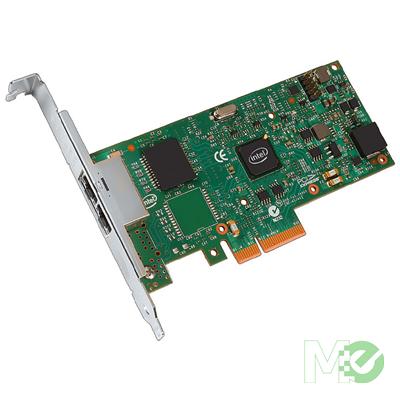
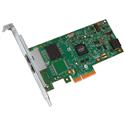
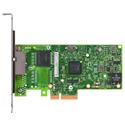
Product Info
Dual Port Gigabit Ethernet Card for Multicore Virtualization CPUs
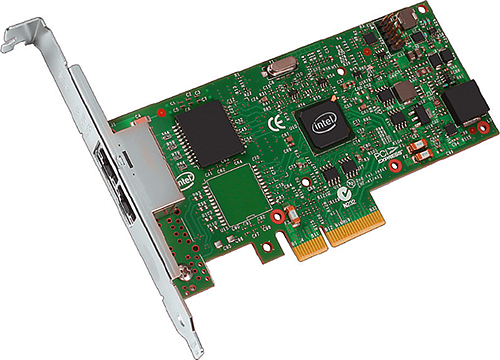
The new Intel® Ethernet Server Adapter I350 family builds on Intel's history of excellence in Ethernet products. Intel continues its market leadership with this new generation of PCIe gigabit Ethernet (GbE) network adapters.
Built with the bridgeless Intel® Ethernet Server Adapter I350, these adapters represent the next step in the GbE networking evolution for the enterprise and data center by introducing new levels of performance through industry-leading enhancements for both virtualized and iSCSI unified networking environments.
This new family of adapters also includes new power management technologies, such as Energy Efficient Ethernet (EEE) and DMA Coalescing (DMAC).
Features
- Halogen-free dual port Gigabit Ethernet adapter with copper interface
- Innovative power management features including Energy Efficient Ethernet (EEE) and DMA Coalescing for increased efficiency and reduced power consumption
- Flexible I/O virtualization for port partitioning & QoS of up to 32 virtual ports
- Scalable iSCSI performance delivering cost-effective SAN connectivity
- High-performing bridgeless design supporting PCI Express Gen 2.1 5GT/s
- Reliable and proven Gigabit Ethernet technology from Intel Corporation
Flexible I/O Virtualization
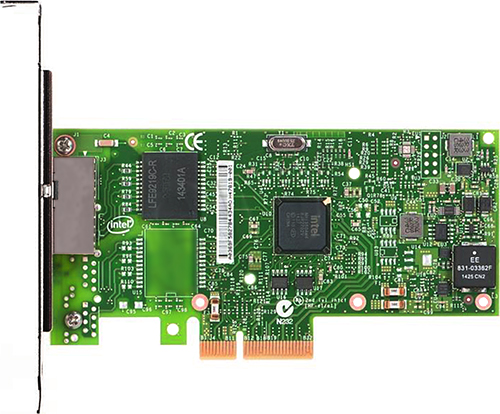
The Intel® Ethernet Server Adapter I350 family includes Intel® Virtualization Technology for connectivity (Intel® VT-c) to deliver I/O virtualization and Quality of Service (QoS) features designed directly into the controller on the adapter. I/O virtualization advances network connectivity models used in today's servers to more efficient models by providing Flexible Port Partitioning (FPP), multiple Rx/Tx queues, and on-controller QoS functionality that can be used in both virtual and non-virtual server deployments.
By taking advantage of the PCI-SIG SR-IOV specification, Intel® Ethernet products enable Flexible Port Partitioning (FPP). With FPP, virtual controllers can be used by the Linux host directly and/or assigned to virtual machines. With this port partitioning, administrators can create up to eight dedicated connections on a single Ethernet port for use in bare-metal and virtualized server deployments.
In a bare-metal Linux server, host processes can be assigned to dedicated network resources to provide traffic isolation and balanced bandwidth allocation.
In a virtualized environment, a VM can be assigned to a virtual controller to reduce the CPU overhead seen when using a software-based network bridge by offloading network traffic management to the controller.
Scalable iSCSI Performance
An Intel Ethernet Server Adapter I350 with native iSCSI initiators built into Microsoft Windows, Linux, and VMware ESX platforms provides a simple, dependable, cost-effective way to connect to iSCSI SANs. These native initiators are broadly tested using multiple generations of operating systems, storage systems, and OS tools to help ensure reliability and ease of use. Standardizing on Intel® Ethernet Adapters for iSCSI enables administrators to use a single initiator, TCP/IP stack, and a common set of management tools and IT policies.
In addition, Intel® Ethernet Server Adapters include a number of hardware features designed to accelerate iSCSI traffic and enhance data processing. For example, TCP segmentation offload and checksum offload capabilities help reduce processor usage, increase throughput, and deliver exceptional iSCSI performance.
Finally, using native OS initiators, an Intel Ethernet Server Adapter I350 supports the CRC-32 digest instruction set included with Intel® Xeon® processor products, which improves transmission reliability and delivers an enterprise class iSCSI solution.
Power Management Technologies
Today, companies everywhere are looking for ways to decrease energy consumption across the enterprise to reduce costs and environmental impact, while at the same time solving increasingly important power density challenges. That's why Intel has introduced new, advanced Power Management Technologies (PMTs) with the Intel Ethernet Server Adapter I350 family that enable enterprises to configure power options on the adapter and more effectively manage their power consumption.
Energy Efficient Ethernet (EEE)
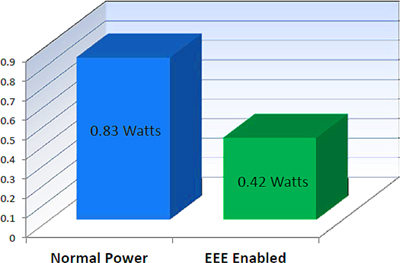
The Intel Ethernet Server Adapter I350 family supports the IEEE802.3az Energy Efficient Ethernet (EEE) standard so that, during periods of low network activity, EEE reduces the power consumption of an Ethernet connection by negotiating with a compliant EEE switch port to transition to a low power idle (LPI) state. This reduces the controller power to approximately 50% of its normal operating power, saving power on the network port and the switch port. As soon as increased network traffic is detected, the controller and the switch quickly come back to full power to handle the increased network traffic. EEE is supported for both 1000BASE-T and 100BASE-TX.
DMA Coalescing
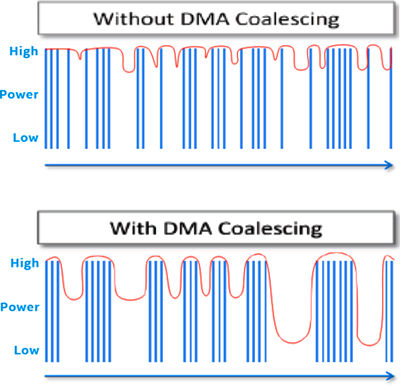
Another power management technology that can reduce power on the server platform is DMA Coalescing (DMAC). Typically, when a packet arrives at a server, DMA calls are made to transfer the packet within the server. These calls wake up the processor, memory and other system components from a lower power state in order to perform the tasks required to handle the incoming packet.
Based on the configurable DMAC settings, incoming packets are buffered momentarily before any DMA calls are made. This enables the controller to intelligently identify opportunities to batch multiple packets together so that when components are wakened from lower power states they can efficiently handle the batched packets at the same time. This enables platform components to remain in lower power states longer, which can dramatically reduce platform energy consumption. DMAC synchronizes DMA calls across all controller ports to ensure maximum power savings.
Software Tools and Management
Intel® Advanced Network Services (Intel® ANS) include new teaming technologies and techniques such as Virtual Machine Load-Balancing (VMLB) for Hyper-V environments. Today, Intel ANS includes a variety of teaming configurations for up to eight adapters, support for mixed vendors server adapters teaming and includes support for 802.1q VLANs, making Intel ANS one of the most capable and comprehensive tools for supporting server adapter teaming.
Additionally, Intel® PROSet for Windows Device Manager and PROset CL extends driver functionality to provide additional reliability and Quality of Service features and configuration.
Manufacturer's Product Brief Sheet Download
Click Here for the Intel Server Adapter i350 Series Product Brief Sheet in .pdf
Specifications
| Interface Ports | 2x RJ-45 ports (Copper) |
|---|---|
| Data Topology | IEEE 802.3/10BASE-T, 100BASE-TX, 1000BASE-T 10/100/1000 Mbps per port |
| Standard Compliance | IEEE 802.3 10BaseT IEEE802.3u 100BaseTX IEEE802.3ab 1000BaseT |
| Cabling | Category-3 or higher for 10BASE-T operation Category-5 or higher for 100BASE-TX operation Category-5e or higher for 1000BASE-T operation |
| Bus | PCI-Express v2.1 x4 Card (5 GT/s) in x4, x8 and x16 slots |
| Compliance | BSMI, CE, CTICK, FCC Class B, KCC, UL, VCCI |
| Temperature | Operating: 0 ~ 55°C (32 ~ 131° F) Storage: -40 ~ 70°C (-10 ~ 158° F) |
| Humidity | Storage: Up to 90% RH, noncondensing @ 35° C |
| Power Consumption | Operating: 0.42W w/ EEE enabled |
| Dimensions (LxW) | 135 x 69mm (5.3 x 2.7") |
| Weight | N/A |



